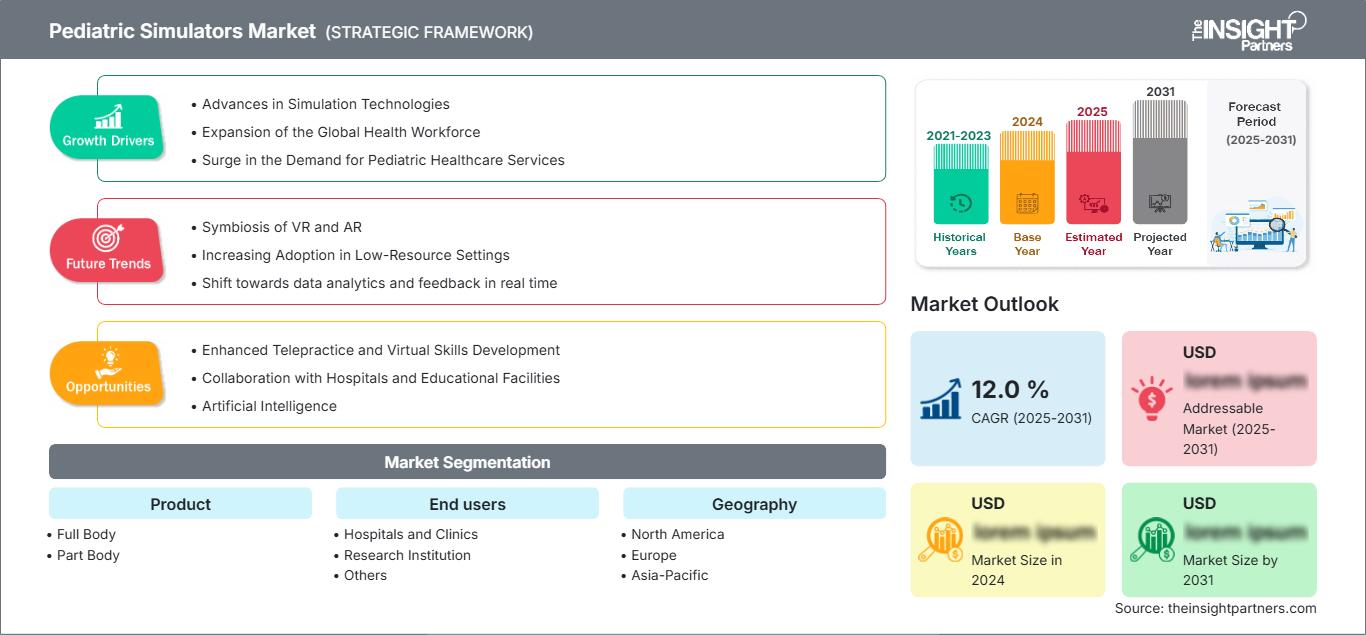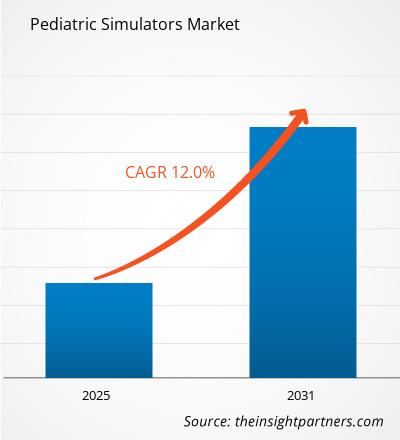The Pediatric Simulators Market is expected to register a CAGR of 12.0 % from 2025 to 2031, with a market size expanding from US$ XX million in 2024 to US$ XX Million by 2031.
The report is segmented by Product (Full Body, Part Body). Also, the report is segmented based on End users(Hospitals and Clinics, Research Institution, Others). The global analysis is further broken-down at regional level and major countries. The report offers the value in USD for the above analysis and segments.
Purpose of the Report
The report Pediatric Simulators Market by The Insight Partners aims to describe the present landscape and future growth, top driving factors, challenges, and opportunities. This will provide insights to various business stakeholders, such as:
- Technology Providers/Manufacturers: To understand the evolving market dynamics and know the potential growth opportunities, enabling them to make informed strategic decisions.
- Investors: To conduct a comprehensive trend analysis regarding the market growth rate, market financial projections, and opportunities that exist across the value chain.
- Regulatory bodies: To regulate policies and police activities in the market with the aim of minimizing abuse, preserving investor trust and confidence, and upholding the integrity and stability of the market.
Pediatric Simulators Market Segmentation
Product
- Full Body
- Part Body
End users
- Hospitals and Clinics
- Research Institution
- Others
You will get customization on any report - free of charge - including parts of this report, or country-level analysis, Excel Data pack, as well as avail great offers and discounts for start-ups & universities
Pediatric Simulators Market: Strategic Insights

- Get Top Key Market Trends of this report.This FREE sample will include data analysis, ranging from market trends to estimates and forecasts.
Pediatric Simulators Market Growth Drivers
- Advances in Simulation Technologies: Advances in simulation technology are coming about in multifaceted ways, including artificial intelligence, virtual reality, and 3D graphics, which is going to change pediatric simulators for the better. Training is going to become even more close to life-like and engaging as a result of higher realism in creating simulations that will enable health care professionals to safely practice the handling of complex or rare cases in pediatrics.
- Expansion of the Global Health Workforce: Most healthcare systems in developing economies face a very significant deficit of qualified professionals; thus, pediatric simulators are becoming increasingly accepted. As countries expand access and enhance quality in medical education, integration of the simulation technology into training of increasingly diversified healthcare workforce cannot be overlooked. Among these practical activities is pediatric simulation that can be undertaken to make health workers, especially in rural or underserved areas, improve services towards better global health service provision.
- Surge in the Demand for Pediatric Healthcare Services: Due to such determinants as the expansion of the younger population and the growing understanding of children’s health, specialized attention is gaining more focus. Pediatric simulators offer an opportunity for healthcare providers to master the management of a range of pediatric conditions and improve clinical outcomes for the patients. The growing need for pediatric care that focuses on advanced techniques is one of the factors that encourage the use of simulation tools in medical education.
Pediatric Simulators Market Future Trends
- Symbiosis of VR and AR: The application of both VR and AR technologies at pediatrics simulators has elevated medical education to a new height. These technologies present an environment fully filled with augmented reality; through them, health care workers can do various pediatric procedures as well as emergency situations. With the advancement of VR and AR, even better functionalities allow even more sophisticated and complex simulations that in turn helps in learning. Therefore, the usefulness of pediatric simulators is greatly enhanced.
- Increasing Adoption in Low-Resource Settings: Pediacare and new versions of pediatric simulators are increasingly being accepted in low-resource and remote areas where no kind of medical training institute may exist. Mobile and affordable simulators enable even such areas to apply training personnel on basic pediatric care without building expensive centers. This is important to achieve equal distribution about quality pediatric training services and improved healthcare in the areas currently under served.
- Shift towards data analytics and feedback in real time: New age pediatric simulators are embedding such features like real-time data analytics in order to upgrade trainings with real time feedback. Simulators do the following things for the trainees and the instructor by analysing the vital signs, how well the procedural steps were practiced, and the timelines in the course of making certain decisions during the practice session. This increases the quality of care being provided because professionals can evaluate their performance and then work on improving efficiency in those particular areas, which is very necessary in pediatric care.
Pediatric Simulators Market Opportunities
- Enhanced Telepractice and Virtual Skills Development: The advent of telehealth services and virtual learning in medicine comes with the possibility of utilizing pediatric simulators within off-site coaching. Most of the time, this is useful for health workers who practice in remote regions. They may be able to use remarkably realistic virtual pediatric simulations made available through the internet. This ensures that demography-based health care trainings can be offered enhancing pediatric health care without having to use participants at specific areas or even sophisticated facilities.
- Collaboration with Hospitals and Educational Facilities: Furthermore, there is a great potential for the growth of the companies developing pediatric simulators based on hospitals and medical institutions collaboration. Resources in simulators suffice for students and trainees in pediatric medicine to have a good deal of practice during their studies. In such cases, cooperative efforts will not only increase the use of pediatric simulators in education, but will also result in their evolution, as more educational and advanced pediatric simulators will be designed for the purpose.
- Artificial Intelligence: The Application of Artificial Intelligence within the training Scenarios for Interactivity: It is particularly fascinating to speak about the inclusion of artificial intelligence in pediatric simulation manikins because it allows for active, individualized, condition-based learning. AI is capable of assessing how well the student is progressing, responding with corrective remarks, and changing levels of objects within the scenario in relation to their physical aptitude. That is how children and health workers get better with paediatric exercises and nutrients and it becomes easier for them to learn distinct forms of practice, thus making better use of the designed tools for training.
Pediatric Simulators Market Regional Insights
The regional trends and factors influencing the Pediatric Simulators Market throughout the forecast period have been thoroughly explained by the analysts at The Insight Partners. This section also discusses Pediatric Simulators Market segments and geography across North America, Europe, Asia Pacific, Middle East and Africa, and South and Central America.
Pediatric Simulators Market Report Scope
| Report Attribute | Details |
|---|---|
| Market size in 2024 | US$ XX million |
| Market Size by 2031 | US$ XX Million |
| Global CAGR (2025 - 2031) | 12.0 % |
| Historical Data | 2021-2023 |
| Forecast period | 2025-2031 |
| Segments Covered |
By Product
|
| Regions and Countries Covered | North America
|
| Market leaders and key company profiles |
|
Pediatric Simulators Market Players Density: Understanding Its Impact on Business Dynamics
The Pediatric Simulators Market is growing rapidly, driven by increasing end-user demand due to factors such as evolving consumer preferences, technological advancements, and greater awareness of the product's benefits. As demand rises, businesses are expanding their offerings, innovating to meet consumer needs, and capitalizing on emerging trends, which further fuels market growth.

- Get the Pediatric Simulators Market top key players overview
Key Selling Points
- Comprehensive Coverage: The report comprehensively covers the analysis of products, services, types, and end users of the Pediatric Simulators Market, providing a holistic landscape.
- Expert Analysis: The report is compiled based on the in-depth understanding of industry experts and analysts.
- Up-to-date Information: The report assures business relevance due to its coverage of recent information and data trends.
- Customization Options: This report can be customized to cater to specific client requirements and suit the business strategies aptly.
The research report on the Pediatric Simulators Market can, therefore, help spearhead the trail of decoding and understanding the industry scenario and growth prospects. Although there can be a few valid concerns, the overall benefits of this report tend to outweigh the disadvantages.
Frequently Asked Questions
How many number of pages is the standard report?
What are the deliverable formats of the pediatric simulators market?
Which players accounted for more than 40% market shares in the year 2023?
What is the expected CAGR of the Pediatric Simulators Market?
Among the region, which is the fastest growing market?
Which type segments accounts for major share in the market?
- Historical Analysis (2 Years), Base Year, Forecast (7 Years) with CAGR
- PEST and SWOT Analysis
- Market Size Value / Volume - Global, Regional, Country
- Industry and Competitive Landscape
- Excel Dataset
Recent Reports
Testimonials
Reason to Buy
- Informed Decision-Making
- Understanding Market Dynamics
- Competitive Analysis
- Identifying Emerging Markets
- Customer Insights
- Market Forecasts
- Risk Mitigation
- Boosting Operational Efficiency
- Strategic Planning
- Investment Justification
- Tracking Industry Innovations
- Aligning with Regulatory Trends





















 Get Free Sample For
Get Free Sample For